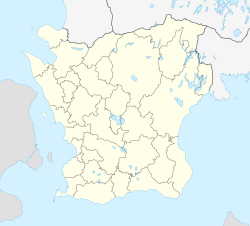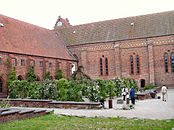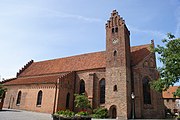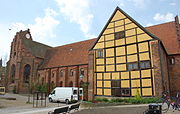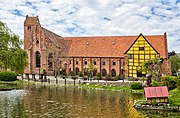Greyfriars Abbey, Ystad
 | |
| Monastery information | |
|---|---|
| Other names | Ystad Abbey |
| Order | Franciscans |
| Established | 1267 |
| Disestablished | 1532 |
| Site | |
| Location | Ystad, Skåne County, Sweden |
| Coordinates | 55°25′51″N 13°49′10″E / 55.43083°N 13.81944°E |
The Greyfriars Abbey (Swedish: Gråbrödraklostret), sometimes also simply Abbey in Ystad (Swedish: Klostret i Ystad), is a medieval former friary in Ystad, Sweden. Together with Vadstena Abbey, it is one of the best-preserved medieval monasteries in Sweden.[1] It houses the Museum of the cultural history of Ystad (Swedish: Klostret i Ystad).
History
According to an inscription from the 14th century, the monastery was founded by a donation by a
In 1532, amidst the ongoing
In 1658, Denmark handed over Ystad and the monastery to Swedish authorities following the Treaty of Roskilde. In 1777, the hospital closed and the premises were taken over by the state-owned akvavit distillery, but as the state abolished its alcohol monopoly in 1786 it became used instead as a granary. In the early 19th century the building was left to decay. In 1877, the building was purchased by the city government and plans both to restore and to pull the building down were ventilated. It was only in 1909, however, that restoration works finally began.[2]
Architecture
The monastery complex consists of three connected buildings: the parish church of St. Peter (the former church of the monastery), the former gatehouse and the one preserved wing originally forming one side of a quadrangle. The buildings are almost exclusively erected in red brick, making the edifice one of the most striking examples in Sweden of Brick Gothic. Surrounding the buildings are a rose garden, laid out in 2002, and a herbal garden, laid out in 1998.[2]
The church of St. Peter
The former church of the monastery is a narrow, rectangular church with whitewashed Gothic groin vaulting and restrained decoration, both on the inside and the exterior. This is typical for Franciscan churches, an outward sign of their pledges of poverty. The nave is flanked by a single aisle to the south. The windows are high and narrow Gothic windows. A bell tower that reaches above the rest of the church is located to the east of the aisle. Externally, the western façade is decorated with blind arches.[2]
The gatehouse
The two-storey gatehouse dates from sometime between the late 14th century and the middle of the 15th, a period in which the monastery was greatly expanded. It originally connected the church with the western wing, now destroyed, which probably housed guest rooms.[2]
The monastery
The one surviving wing of the monastery proper is a rectangular building with a
Gallery
-
Exterior view from the north-west
-
Exterior view from the south-east
-
Exterior view from the north-east
-
Interior view of the church
-
Greyfriars Abbey, Ystad
See also
- List of Brick Gothic buildings
- List of monasteries in Sweden
- St. Mary's Church, Ystad
References
- ^ "The Monastery in Ystad". Culturalnarrative.com. Retrieved April 27, 2013.
- ^ a b c d e f g Lund, Carola (2006). Klostret i Ystad (in Swedish). Malmö kulturmiljö, enheten för kulturmiljövård.
External links
- Official webpage (in Swedish)
 Media related to Greyfriars Abbey, Ystad at Wikimedia Commons
Media related to Greyfriars Abbey, Ystad at Wikimedia Commons

